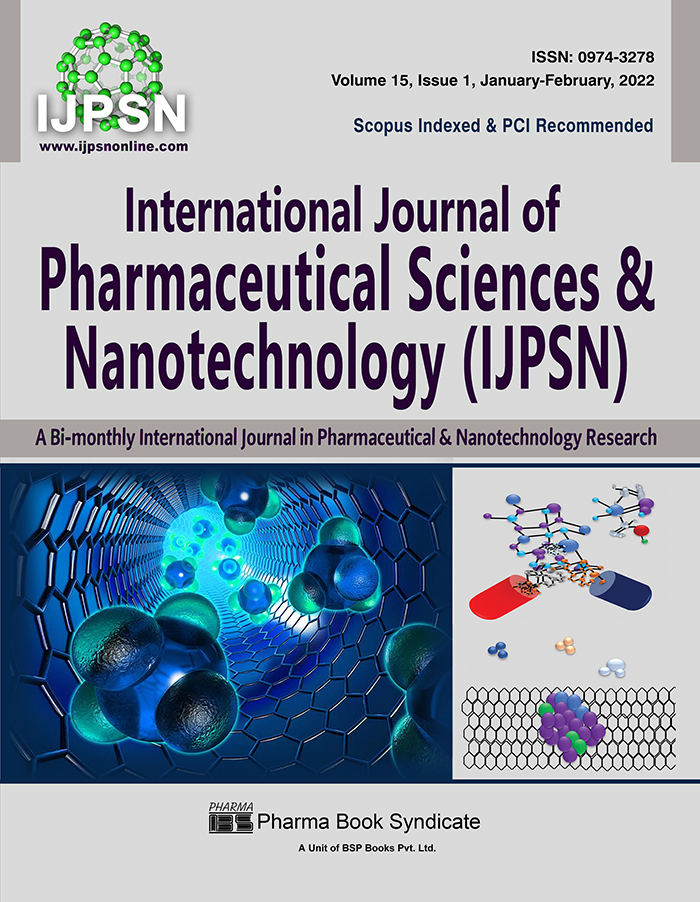Guidelines for Nanopharmaceutical Products for Regulatory Approval
DOI:
https://doi.org/10.37285/ijpsn.2022.15.1.1Abstract
The word 'nano' refers to a Greek prefix that means 'dwarf' or very little,' and represents a thousand millionth of a meter (10-9) in length. Nanoscience and nanotechnology are the study and application of nanoscale range materials. Initially, the term Nanotechnology was used by N. Taniguchi in 1974 at an international conference on industrial production in Tokyo to characterize the super-thin processing of materials with nanometre accuracy and the fabrication of nano-sized systems (Bayda S. et al., 2020). The usage of nanomaterials has enhanced the application of nanomedicine in various therapeutics area with challenges and limitations over the last ten years. Alteration of the physiochemical, biological, mechanical & other properties of the materials made the nanomaterials and it can be utilized in different useful activities such as drug development, drug target. Nanotechnology utilized novel nanomaterials to make useful products. This technology has been used to overcome the limitations & challenges in different drug therapies. (Harea JI et al., 2017).
The combination of nanotechnology with pharmaceuticals and biomedicals is termed nano pharmaceutical. Nanopharmaceuticals is a new technology in current practice. As a result, there are no widely agreed nanopharmaceuticals guidelines. The general idea of regulatory requirements for Active Pharmaceutical Ingredients (API), as stated in the CDSCO's New Drugs and Clinical Trial Rules 2019, was mandatory in drug development pathways. These criteria are also in line with the International Council for Harmonization (ICH) recommendations and international standards that other countries using such items follow. New Drugs and Clinical Trials Rules, 2019 should be followed in different drug development. (Harea JI et al., 2017).
Globally, there are important guidelines developed by the United States Food & Drugs Administration (USFDA), International Council for Harmonization (ICH), or Organization for Economic Co-operation and Development (OECD). (Harea JI et al., 2017).
Current regulatory approaches by US Food & Drug Administration (FDA), established the nanotechnology task force in August 2006. This regulatory approach encourages the development of nanoproducts. FDA has issued the guidelines in 2007 to the industry to address the benefits & risks of Drugs, medical devices, and other nanoproducts. FDA is also working with other U.S. government agencies to focus on the safety & efficacy of nanoproducts and U.S. initiates the National Nanotechnology Initiative (NNI) which is a federal research & development program to coordinate the effort of all government agencies involved in nanotechnology. The main goal of the NNI is to maintain the class of research & development program, encourage inducing the new technologies in the product, developing the supporting infrastructure & tools needed for nanotechnology (Ventola et al., 2012).
Downloads
Metrics
Keywords:
Nanopharmaceutical ProductsDownloads
Published
How to Cite
Issue
Section
References
Bayda S, Adeel M, Tuccinardi T, Cordani M, Rizzolio F. The history of nanoscience and nanotechnology: From chemical– physical applications to nanomedicine. Molecules. 2020 Jan;25(1):112.
DBT. Guidelines for Evaluation of Nanopharmaceuticals In India. 2019 Oct, 1-13 https://dbtindia.gov.in/sites/default /files/uploadfiles/Guidelines%20For%20Evaluation%20of%20N anopharmaceuticals%20in%20India.pdf.
Foulkes, Rachel; Man, Ernest; Thind, Jasmine; Yeung, Suet; Joy, Abigail; Hoskins, Clare (2020). The regulation of nanomaterials and nanomedicines for clinical application: current and future perspectives. Biomaterials Science, (), 10.1039.
Harea JI, Lammers T, Ashford MB, Purie S, Barrya ST. Challenges and strategies in anti-cancer nanomedicine development: An industry perspective. Advanced Drug Delivery Reviews. 2017;108:25–38
Malik R, Patil S. Nanotechnology: Regulatory Outlook on Nanomaterials and Nanomedicines in United States, Europe and India. Applied Clinical Research, Clinical Trials and Regulatory Affairs. 2020 Dec 1;7(3):225-36.
S. Bremer-Hoffmann, B. Halamoda-Kenzaoui and S. Borogs, Join, 2018, 3, 1.
Ventola CL. The nanomedicine revolution: part 3: regulatory and safety challenges. P T. 2012 Nov;37(11):631-9.






